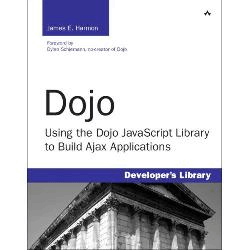
Dojo: Using the Dojo JavaScript Library 85
stoolpigeon writes "The number and functionality of web based applications has exploded recently. Many of these applications rely heavily on AJAX to provide a more desktop-like experience for users. As the number of people using JavaScript grew, libraries were developed to assist with commonly encountered issues. Jim Harmon's new book Dojo: Using the Dojo JavaScript Library to Build Ajax Applications aims to introduce readers to one of those libraries, the Dojo Toolkit." Keep reading for the rest of JR's review.
The Dojo Toolkit, is a JavaScript library, created to increase the speed of writing JavaScript applications. It provides developers with widgets, themes, wrappers for asynchronous communication, client side storage and more. It does all this across various browsers and platforms without requiring the user to worry about differences in browsers.
| Dojo: Using the Dojo JavaScript Library to Build Ajax Applications | |
| author | James E. Harmon |
| pages | 316 |
| publisher | Addison-Wesley Professional |
| rating | 7/10 |
| reviewer | JR Peck |
| ISBN | 978-0-13-235804-0 |
| summary | a complete example rich developer's guide to Dojo |
The book follows an interesting pattern. It begins with a five chapter tutorial. The tutorial launches immediately into taking a straight html form and using Dojo widgets to add functionality. All of the code used in the tutorial is available at the book's web site. This tutorial moves quickly, introducing a number of available widgets and giving the reader a nice feel for how Dojo integrates with html markup.
What does not take place in the tutorial is the normal introductory material on just what Dojo is, how it is installed, or what it can do. I'm guessing that this will be a welcome change to those used to quickly brushing past the first chapter, or more, of any programming book. Harmon takes advantage of the fact that Dojo is available via the AOL Content Delivery Network, so the examples will work any javascript capable browser connected to the internet. He does give a quick explanation of what would need to be different to use local files.
All of the introductory material that I'm use to seeing is still in the book but it does not appear until chapter ten. There Harmon covers the motivation to develop Dojo, explains the history of the project, provides a bit of information regarding the dual-licensing of Dojo. (It is available under the BSD and Academic Free Licenses.) This leads into the last seven chapters, that cover the 'deeper' material in the book.
Between the tutorial and chapter ten, there are four chapters of widget documentation with examples and some explanation. Of the three sections this is the longest, though this is in part due to sometimes large sections of white space, as each widget begins on it's own page. The documentation covers each widget and provides a visual representation where applicable. There is some repetition as this section covers widgets that were used in the first section's tutorial.
The third section is entitled "Dojo in Detail." It's the level of detail that marks this book as more of an overview, rather than an in-depth treatment of Dojo. Harmon is true to the title, this book is an extremely pragmatic guide to getting started with Dojo as a means of adding Ajax to applications. It is not however going to take the reader to any great depth into the toolkit. There is plenty here to get started, and enough to hit the ground running, but anyone to get really in-depth coverage of the library will be disappointed.
The person who will get the most out of this book is someone with some knowledge of mark-up and programming but not to an advanced level. The developer with a lot of experience will probably be frustrated with the amount of explanation and repetition of simple material combined with the lack of depth. The reader with no programming experience may struggle, though they could keep up if they are willing to look outside the book for a few resources to get a good grasp of web technologies. They may become extremely frustrated with some of the later chapters where the code examples skip steps and leave the reader to assume what has happened in between what is shown and the output.
That said, this book allows the reader to dive in quickly, get a quick overview and move immediately to making use of the Dojo Toolkit. If one is not concerned with gaining insight on every aspect of the library but would rather just get into it immediately with a little guidance, this may be just right.
With this in mind, it would have been nice if the book had provided less time on documentation and more on examples and ideas for how to best use the capabilities of Dojo. It is nice to have a book that isn't so huge that it is overwhelming and difficult to find anything. But if something had to be given up to keep things compact, I'd have much rather lost things that are easy to find in the on-line documentation and subject to change as the toolkit develops. This keeps the book from being excellent, but it is still a solid introduction and primer.
You can purchase Dojo: Using the Dojo JavaScript Library to Build Ajax Applications from amazon.com. Slashdot welcomes readers' book reviews -- to see your own review here, read the book review guidelines, then visit the submission page.

look at you hacker... (Score:2, Funny)
Re:Is it jquery? (Score:4, Funny)
Well, I'll tell you one thing: IBM is a primary sponsor of the Dojo foundation. Not so for jQuery and prototype. If IBM isn't a good enough reason to stay the heck away, I don't know what is.